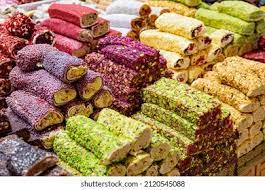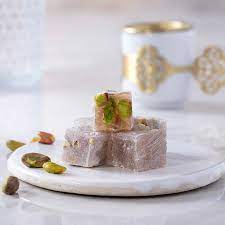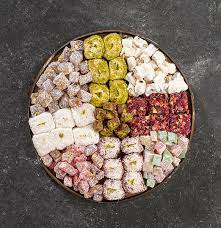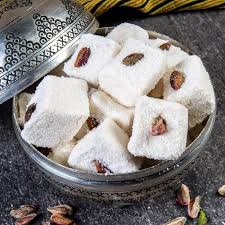Introduction:
Lokum, also known as Turkish Delight, is a mouthwatering confectionary delight that has captivated taste buds for centuries. This unique treat, with its soft and chewy texture, delightful flavors, and delicate dusting of powdered sugar, holds a special place in Turkish culinary heritage. With a history dating back hundreds of years, lokum has evolved into a beloved sweet enjoyed not only in Turkey but also around the world. Join us on a delectable journey as we delve into the rich history, diverse flavors, and cultural significance of lokum.
Historical Origins:
The origins of lokum can be traced back to the Ottoman Empire, where it was first created in the royal kitchens as a luxurious treat for the sultans and their courts. The precise origins of lokum are shrouded in mystery, with various legends and tales surrounding its creation. One such legend tells the story of a palace chef who concocted a sweet delight using honey, fruit extracts, and aromatic spices, which pleased Sultan Mahmud II so much that it became an instant sensation.
The story of lokum, or Turkish Delight, is steeped in history and legend, dating back centuries to the time of the Ottoman Empire. While the exact origin of lokum is shrouded in mystery, there are several intriguing tales surrounding its creation.
One popular legend tells the story of a palace chef named Bekir Effendi during the reign of Sultan Mahmud II in the early 19th century. According to the legend, Bekir Effendi was experimenting with various confections in the royal kitchen when he stumbled upon the recipe for what would become lokum. Using ingredients such as sugar, water, starch, and fragrant flavorings like rosewater and citrus extracts, he created a soft and chewy treat that delighted the sultan and his court.
Impressed by the new creation, Sultan Mahmud II named the confection "lokum," which means "morsel" or "mouthful" in Turkish. He was so fond of it that he declared it to be a royal delicacy and made it available exclusively to the palace and the highest-ranking officials. However, as the treat gained popularity among the aristocracy, it eventually made its way to the wider public and became a beloved sweet enjoyed by people of all backgrounds.
While this legend is widely known and cherished, it is important to note that the true origins of lokum might predate Bekir Effendi's story. It is believed that a similar sweet was enjoyed in the Middle East and Persia long before it reached the Ottoman Empire. As trade routes expanded and cultural exchanges occurred, the recipe and techniques for making lokum might have been brought to the empire, where it was refined and further developed.
Regardless of its exact origins, lokum quickly gained popularity in the Ottoman Empire and became a staple of Turkish cuisine. It was not only enjoyed by the sultans and the elite but also became a treasured treat among the general population. Lokum shops, known as "lokumcuzade," began to appear throughout Istanbul and other major cities, offering a variety of flavors and styles to satisfy different tastes.
Over time, lokum evolved to include a wide range of flavors and fillings. Traditional lokum varieties include fragrant floral flavors like rose, citrus flavors such as lemon and orange, as well as nut-filled options like pistachio or hazelnut. Each flavor offers a unique sensory experience, enticing people with their aromas and textures.
Lokum's cultural significance goes beyond its delectable taste. It is often associated with hospitality, generosity, and celebration in Turkish culture. Lokum is commonly served to guests as a gesture of welcome and is a traditional treat offered during important occasions such as weddings, religious holidays, and festive gatherings.
Today, lokum continues to be cherished both in Turkey and around the world. Its popularity has spread far beyond its birthplace, with lokum shops and specialty stores found in various countries. The confection has also inspired creative adaptations and fusion flavors, showcasing its versatility and adaptability to modern tastes.
the story of lokum is one of enchantment and indulgence. From its mysterious origins to its status as a beloved Turkish delicacy, lokum has carved a sweet spot in culinary history. Whether enjoyed for its rich heritage, unique flavors, or cultural symbolism, lokum remains an exquisite treat that delights the senses and brings joy to all who taste it.

Ingredients and Preparation:
Lokum is traditionally made using a combination of starch, sugar, water, and flavorings such as rosewater, lemon, orange, or mastic. These ingredients are carefully mixed and heated to create a thick, sticky syrup, which is then poured into trays and left to cool and set. Once set, the lokum is cut into small, bite -sized cubes and generously dusted with powdered sugar
The traditional ingredients and preparation of lokum involve a few key components that contribute to its unique texture and flavor. Here is a breakdown of the typical ingredients and the process of making lokum:
Ingredients:
Sugar: The main sweetening agent that provides the base for lokum.
Water: Used to dissolve and combine the sugar and other ingredients.
Cornstarch or gelatin: These ingredients help thicken the mixture and give lokum its characteristic chewy texture.
Flavorings: Traditional lokum is often flavored with natural extracts such as rosewater, lemon, orange, or other fruit flavors. These add aroma and enhance the taste.
Nuts or dried fruits (optional): Some varieties of lokum include chopped nuts like pistachios or almonds, or small pieces of dried fruits, adding texture and flavor.
Preparation:
Mixing the sugar and water: In a large pot or saucepan, the sugar and water are combined and heated over medium heat until the sugar dissolves completely, creating a syrup-like mixture.
Boiling the syrup: The mixture is then brought to a boil, stirring continuously to prevent burning and to ensure even heat distribution.
Adding cornstarch or gelatin: Once the mixture reaches a rolling boil, cornstarch or gelatin is gradually added while stirring vigorously. This helps thicken the mixture and gives it a gel-like consistency.
Flavoring and coloring: At this stage, the desired flavorings and colorings are added to the mixture. Rosewater, citrus extracts, or other natural flavorings are commonly used to infuse the lokum with their distinct aromas and tastes. Food coloring may also be added to achieve vibrant hues.
Cooking and thickening: The mixture is cooked further over low heat, stirring continuously, until it thickens and develops a smooth, glossy texture. This process may take some time, and the mixture needs to be constantly stirred to prevent lumps from forming.
Adding nuts or dried fruits (optional): If desired, chopped nuts or dried fruits can be incorporated into the mixture at this stage, adding an additional layer of flavor and texture.
Shaping and setting: Once the mixture has reached the desired consistency, it is poured into a prepared pan or mold lined with powdered sugar or starch to prevent sticking. The lokum is then left to cool and set for several hours or overnight.
Cutting and coating: Once fully set, the lokum is removed from the pan and cut into small squares or rectangles. Each piece is typically rolled in powdered sugar or starch to prevent them from sticking together.
Storage: Lokum is usually stored in an airtight container to maintain its freshness and chewy texture. It can be enjoyed for several weeks or even longer when stored properly.
It's worth noting that there are numerous variations and regional adaptations of lokum, and the ingredients and preparation methods may vary slightly depending on personal preferences and specific recipes.

Varieties of Lokum:
Lokum comes in a wide array of flavors and combinations, offering something to satisfy every palate. Traditional lokum varieties include rose, lemon, orange, pistachio, and mint, each boasting its own unique taste and aroma. Over the years, modern twists on lokum have emerged, incorporating ingredients such as chocolate, nuts, coconut, and even exotic spices. Whether you prefer the classic floral notes of rosewater or the nutty crunch of pistachios, there is a lokum flavor to suit every preference.
Lokum, also known as Turkish delight, comes in a wide array of flavors and varieties. Here are some popular varieties of lokum:
Traditional Lokum: This is the classic version of lokum that is flavored with rosewater and dusted with powdered sugar. It has a delicate floral aroma and a soft, chewy texture.
Fruit Lokum: These lokum varieties incorporate natural fruit flavors such as lemon, orange, raspberry, or cherry. They often have a tangy and refreshing taste, complemented by the sweetness of the sugar syrup.
Nut Lokum: Lokum can also feature the addition of various nuts, such as pistachios, almonds, hazelnuts, or walnuts. The nuts are either embedded within the lokum or sprinkled on top, providing a delightful crunch and nutty flavor.
Chocolate Lokum: For chocolate lovers, there are lokum varieties that are coated in or infused with chocolate. These offer a rich and indulgent taste, combining the sweetness of lokum with the smoothness of chocolate.
Coconut Lokum: These lokum pieces are coated in shredded coconut, adding a tropical twist to the traditional recipe. The coconut flakes provide a subtle crunch and a hint of tropical flavor.
Coffee Lokum: Coffee-flavored lokum is infused with the aroma and taste of coffee, creating a harmonious blend of sweetness and a hint of bitterness. It appeals to coffee enthusiasts looking for a unique twist on the classic lokum.
Spiced Lokum: Lokum can also be enhanced with spices like cinnamon, cardamom, or nutmeg, giving it a warm and aromatic profile. These spiced varieties offer a delightful combination of sweetness and spice.
Herbal Lokum: Lokum infused with herbal extracts or essences, such as mint or lavender, provides a refreshing and soothing flavor. It offers a unique twist on the traditional lokum taste, appealing to those who enjoy herbal infusions.
These are just a few examples of the diverse range of lokum varieties available. Lokum artisans and confectioners often experiment with different flavors, combinations, and presentations, resulting in a rich tapestry of options for lokum enthusiasts to explore and enjoy.

Cultural Significance for lokum
Lokum, or Turkish delight, holds significant cultural importance, particularly in Turkish and Middle Eastern traditions. Here are some aspects of its cultural significance:
Heritage and Tradition: Lokum has a long history and is deeply rooted in Turkish culture. It is considered a traditional sweet that has been enjoyed for centuries. It is often associated with hospitality, celebrations, and special occasions.
Symbol of Generosity and Welcome: Offering lokum to guests is a common gesture of hospitality in Turkey and the Middle East. It symbolizes warmth, generosity, and a welcoming spirit. It is often served with Turkish tea, creating a delightful combination of flavors.
Festivals and Celebrations: Lokum plays a prominent role in various festivals and celebrations. It is often served during religious holidays like Eid al-Fitr and Eid al-Adha in Muslim cultures. Lokum is also a popular treat during weddings, engagements, and other joyous occasions.
Souvenir and Gift: Lokum is a popular souvenir for visitors to Turkey and the Middle East. Its unique flavors, vibrant colors, and beautiful packaging make it a sought-after gift item. It is often presented in decorative boxes, making it an ideal choice for sharing a taste of Turkish culture with friends and family.
Culinary Heritage: Lokum is considered a culinary treasure and an integral part of Turkish cuisine. It showcases the artistry and craftsmanship of Turkish confectioners. The traditional production process and the use of high-quality ingredients have been passed down through generations, preserving its cultural significance.
Cultural Exchange: Lokum has gained international recognition and popularity, becoming a symbol of Turkish and Middle Eastern cuisine worldwide. It serves as a bridge between cultures, as people from different backgrounds come to appreciate and enjoy its unique flavors and textures.
Artistic Expression: Lokum making is considered an art form in itself. The intricate designs, vibrant colors, and creative presentations demonstrate the craftsmanship and creativity of lokum artisans. It is not only a delicious treat but also a visual delight.
Overall, lokum holds cultural significance as a symbol of hospitality, celebration, and Turkish heritage. Its presence in traditional ceremonies, its role as a gift or souvenir, and its culinary importance all contribute to its cultural value and the appreciation of Turkish and Middle Eastern traditions.

Lokum, has gained global popularity and influence over the years. Here are some key points regarding its global reach:
Culinary Exploration: Lokum's unique flavors and textures have intrigued and captivated people from various cultures. As international travel and cultural exchange have increased, lokum has become more accessible worldwide, allowing people to experience and appreciate its distinctive taste.
Tourist Attraction: Countries like Turkey, where lokum has its roots, have become popular tourist destinations. Visitors are often drawn to local markets and specialty shops to sample and purchase authentic lokum. Its status as a cultural delicacy contributes to its appeal as a must-try treat.
International Availability: Lokum is now widely available in many countries beyond its place of origin. It can be found in specialty food stores, gourmet shops, and online marketplaces, allowing people to enjoy its flavors without traveling to the source. This availability has helped spread its popularity globally.
Cultural Fusion: Lokum's global popularity has led to its incorporation into various cuisines and culinary creations. It has inspired chefs and confectioners worldwide to experiment with new flavors, combinations, and presentations, incorporating lokum into desserts, ice creams, pastries, and more. This fusion of cultures showcases its influence on international culinary trends.
Food Tourism and Experiences: Lokum has become a part of food tourism, with dedicated food tours and experiences highlighting its significance. Travelers seek out authentic lokum shops, participate in lokum-making workshops, and indulge in lokum tastings as part of their cultural exploration.
Influence in Pop Culture: Lokum has made appearances in literature, films, and other forms of popular culture, further contributing to its global recognition. It has been referenced in various contexts, portraying its association with Turkish and Middle Eastern traditions.
Artisanal and Premium Offerings: Lokum has evolved beyond its traditional forms, with artisanal producers and premium brands offering gourmet varieties. These elevated versions cater to a discerning audience, emphasizing quality ingredients, innovative flavors, and exquisite packaging. This development has elevated the status of lokum as a luxurious and sophisticated treat.
the global popularity and influence of lokum have been driven by its unique flavors, cultural significance, and increased exposure through travel, international availability, and fusion with other culinary traditions. As a result, it continues to captivate the taste buds and inspire culinary innovation worldwide
Turkey is a major exporter of lokum (Turkish delight). The country has a long-standing tradition of producing and exporting lokum, and it is one of the most famous Turkish culinary exports. Turkish delight is sought after by confectionery lovers around the world, and Turkey plays a significant role in meeting the global demand.
Turkish delight manufacturers in Turkey produce a wide variety of lokum flavors, using traditional recipes and techniques that have been passed down through generations. These manufacturers range from small family-owned businesses to large-scale production facilities. They ensure that the quality and authenticity of Turkish delight are maintained throughout the manufacturing process.
Turkey's export of lokum is not limited to the raw product alone. Many Turkish delight producers have expanded their offerings to include packaged and branded versions of lokum, catering to different markets and consumer preferences. These packaged varieties are often available in various flavors, shapes, and packaging designs, making them attractive as souvenirs or gifts.
The popularity of Turkish delight has contributed to its export success. Turkish delight is exported to countries all over the world, including Europe, North America, the Middle East, Asia, and beyond. It is commonly found in international grocery stores, specialty food shops, and online retailers, allowing people from different countries to enjoy the sweet treat.
The export of lokum not only contributes to Turkey's economy but also helps promote Turkish culture and cuisine globally. It serves as an ambassador for Turkish culinary traditions and craftsmanship. The demand for Turkish delight continues to grow, and Turkish manufacturers actively participate in international trade fairs and exhibitions to showcase their products and establish business relationships with buyers from around the world.
Turkey is a significant exporter of lokum, and its exports play a vital role in meeting the global demand for this beloved Turkish confectionery. Turkish delight holds a special place in Turkish culture and is a source of pride for the country.

Several Turkish cities are famous for making lokum (Turkish delight), each with its own unique styles and flavors. Here are some of the most renowned cities in Turkey known for their production of lokum:
Istanbul: As Turkey's largest city and cultural hub, Istanbul is known for producing a wide range of lokum varieties. Many famous lokum shops and confectioneries can be found in Istanbul, offering traditional and innovative flavors to cater to locals and tourists alike.
Bursa: Bursa is often referred to as the birthplace of Turkish delight. It has a rich history in lokum production and is renowned for its high-quality varieties. Bursa-style lokum typically has a soft, chewy texture and comes in various flavors, including rose, lemon, pistachio, and pomegranate.
Safranbolu: Located in the Karabuk province, Safranbolu is famous for its unique saffron-infused lokum. Saffron adds a distinct aroma and flavor to the lokum, giving it a luxurious and exotic touch. Safranbolu-style lokum is highly sought after and makes for a delightful culinary experience.
Gaziantep: Gaziantep, known as the culinary capital of Turkey, is famous for its gastronomy, including its exceptional lokum. Gaziantep-style lokum is distinguished by its rich flavors and generous use of local ingredients, such as pistachios and other nuts. The combination of intense flavors and high-quality ingredients makes Gaziantep a must-visit city for lokum enthusiasts.
Kastamonu: Kastamonu, located in northern Turkey, is known for its traditional Ottoman-style lokum. This type of lokum is made using traditional recipes and techniques passed down through generations. Kastamonu-style lokum is often prepared with natural ingredients and has a distinct texture and taste that sets it apart.
While these cities are particularly renowned for their lokum production, it's important to note that Turkish delight is made and enjoyed throughout the country. Each region may have its own local specialties and variations of lokum, contributing to the diverse and rich culinary heritage of Turkey.
In conclusion, lokum, also known as Turkish delight, is a beloved confectionery with a rich history and cultural significance in Turkey. Its origins can be traced back centuries, and it has become an integral part of Turkish cuisine and traditions.
Lokum is made using a combination of ingredients such as sugar, starch, flavorings, and sometimes nuts or dried fruits. It is prepared through a meticulous process of cooking, cooling, cutting, and coating with powdered sugar or other toppings.
This delectable treat comes in a wide variety of flavors, ranging from traditional favorites like rose, lemon, and pistachio to more innovative combinations. Each region in Turkey may have its own unique style and flavors of lokum, adding to its diversity and appeal.
Lokum holds cultural significance in Turkey, being associated with hospitality, celebrations, and gift-giving. It is often served alongside Turkish tea, symbolizing warm hospitality and friendship. Lokum has also been mentioned in literature and is considered a symbol of Turkish culinary heritage.
Over the years, lokum has gained global popularity and has become a sought-after treat worldwide. Its unique texture, delightful flavors, and exotic appeal have made it a favorite among confectionery enthusiasts. Lokum can now be found in specialty shops and gourmet stores around the world, spreading the flavors of Turkey to different cultures and cuisines.
Turkey, as the birthplace of lokum, remains a significant exporter of this sweet delight. Turkish lokum has made its way to various countries, introducing people to the flavors and traditions of Turkish cuisine.
In summary, lokum is a delicious and iconic Turkish sweet with a fascinating history, a wide array of flavors, and cultural significance. Whether enjoyed as a traditional treat or in modern variations, lokum continues to captivate taste buds and bring joy to people worldwide.
